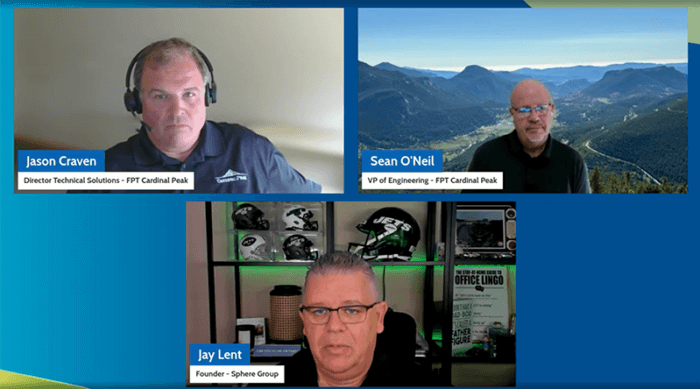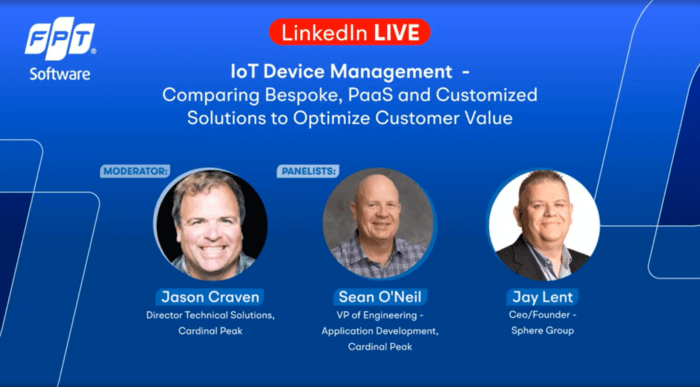Let’s face it: We live in a world of connected devices. With the costs surrounding connected device engineering shrinking, the Internet of Things is exploding — with the number of IoT devices forecasted to grow to more than 8 billion by 2033.
From planning and onboarding to monitoring and maintenance to end-of-life support, managing IoT device fleets can be one of the most complicated aspects of building connected solutions. IoT engineering spans multiple technical disciplines: hardware, embedded software, connectivity, security, cloud infrastructure, mobile application development and more. Weaknesses in any of these areas can make your connected product much harder to register, organize, monitor and remotely manage.
As this ecosystem grows more interdependent and intricate, companies face critical decisions about how to manage IoT device fleets efficiently and securely. To aid the decision-making process, we recently hosted a LinkedIn Live event to compare custom solutions and platform-as-a-service (PaaS) options and highlight the emergence of accelerators.
Contents
What is IoT Device Management?
 IoT device management encompasses three main areas:
IoT device management encompasses three main areas:
- Managing devices.
- Command and control.
- Visibility into device operations and customer usage.
The control, monitoring and maintenance of connected devices becomes particularly challenging at scale — with large fleets exceeding 10,000 devices which demand centralized control. When things aren’t quite going correctly, being able to react is critical.
IoT Fleet Management Considerations
When managing diverse IoT ecosystems, companies frequently decide between several common factors.
IoT Device Management Costs
PaaS IoT fleet management solutions can range from a quarter to half a million dollars upfront and include ongoing maintenance fees. These costs have evolved, with some providers offering more comprehensive services. Depending on the complexity, bespoke solutions can reach the million-dollar price tag. An accelerator should reduce the overall non-recurring engineering (NRE) costs of launching an IoT management platform.
IoT Fleet Management Security and Compliance
Regardless of the chosen approach, don’t overlook security certifications and compliance when selecting a solution, especially given the potential for geopolitical and regulatory risks with global providers.
IoT Solution Migration
For companies considering a switch from PaaS to custom solutions, a few common scenarios exist for IoT platform migration:
- Building a new product.
- Maintaining multiple apps.
- Migrating existing products.
Each scenario presents unique challenges, including the need for cooperation from PaaS providers and potential end-user confusion.
Managing Multiple IoT Applications
While we do not recommend abandoning old devices, maintaining two platforms can add challenges and costs. Options include:
- Maintaining the old IoT platform for existing devices with a planned future sunset or migration date.
- Building a new, more flexible platform for new devices from scratch.
- Migrating custom solutions to a private cloud solution if you own the code and data. As an ESP RainMaker Preferred Integration Partner, we use RainMaker, a cloud serverless solution that leverages AWS IoT Core and incorporates over 100 developer years of engineering and testing at scale.
- Working with your current PaaS provider to securely transfer data, ensure compatibility with new systems and transition devices while minimizing service disruptions.
So, what are your IoT fleet management options?
You can customize a solution to your company’s unique needs or use an existing PaaS solution that likely covers 70% of the requirements for pushing out a connected product and managing it in the real world. Let’s look at each option in a little more detail.
The PaaS Approach to IoT
PaaS solutions offer a shared infrastructure with standard features that can be customized to some extent. For IoT management, the PaaS option typically offers efficiency and scalability, enabling faster time to market and reduced engineering requirements.
These solutions don’t require significant engineering expertise and can bring development timelines down from years to just a few months. PaaS providers often offer guidance on product development and post-launch managed services. Examples of PaaS providers include Tuya, Ayla Networks, Afero, Pepper, Lexi and Particle.io.
PaaS options typically suit smaller companies with limited budgets or companies operating in industries where every second counts in the race to market. Despite the benefits they unlock, PaaS solutions may require customization and lead to feature deployment delays. There’s also a risk of vendor lock-in and dependence on providers for data control and feature updates. You don’t control your own destiny.
Enter custom solutions.
Custom IoT Solutions: Control — at a Cost
Custom solutions offer more control and flexibility but require significant upfront investment and development time. They allow companies to tailor their IoT management precisely to their needs but come with risks of over- or underprovisioning resources.
Solutions customized to a company’s IoT fleet needs are — as a result — much more expensive to launch than PaaS solutions but offer more control over the product roadmap. This approach is preferable for companies with specific requirements that off-the-shelf solutions can’t meet. With build-your-own solutions, you get exactly what you want, but the development demands significantly more effort since most of it doesn’t exist yet.
Risks include performance issues as you scale up through the different numbers of deployed and managed devices. And as features are added, there’s more interaction between the cloud, the devices and the mobile app — and inherently more risk.
While custom solutions offer maximum control and PaaS provides quick deployment, many companies seek a middle ground that combines the best of both worlds. “Accelerators” provide a promising IoT device management compromise.
IoT Accelerators: Bridging the Gap
In IoT fleet management, an “accelerator” uses another framework to help deliver a solution faster to the market. Accelerators offer core aspects of the IoT device fleet management solution, including cloud connectivity, security, certificates, onboarding, updates, reporting and more — out of the box, with some feature customization. Accelerators are built in your own private cloud environment, with managed infrastructure as code, embedded software and SDKs ensuring rapid deployment and reliable performance. Here, you do control your destiny, with significant NRE cost savings compared to a custom-build solution.
For example, a smart home product accelerator may already have software for connecting to the cloud, authenticating the device and updating it (developers), connecting a lightbulb to a Wi-Fi network, scheduling the on/offs and grouping devices for lighting rooms (users).
We’ve dug into several accelerators and use RainMaker, AWS IoT Core and AWS IoT ExpressLink to connect devices.
Of course, the burden on product engineers varies between the three approaches to managing IoT devices.
Engineering Requirements Across IoT Fleet Management Approaches
The engineering requirements differ significantly between custom solutions, PaaS and accelerator-based approaches:
- Like building your own operating system, custom solutions require extensive engineering hours and resources. The cost alone can hinder your ability to innovate and respond promptly. Additionally, launching a custom or private cloud solution requires companies to plan for ongoing maintenance and customer support, which can either be handled internally or outsourced to a managed service provider.
- PaaS offers a more drag-and-drop approach with limited customization options, suitable for basic use cases but potentially limiting for unique requirements and your product goals.
- Accelerators provide a foundation of connectivity, security, user management and updates while allowing for custom feature development in your private cloud. This approach offers a balance between proven solutions and product uniqueness. Even with an accelerator, determining who will manage long-term support and maintenance — whether through internal resources or a managed service provider — remains crucial.
Connect with Cardinal Peak for Accelerated IoT Fleet Management
Companies entering the space now have more IoT device management options than ever. When choosing between custom solutions, PaaS or accelerator-based approaches, companies must carefully weigh factors like scale, cost, control, security, long-term flexibility and the engineering impact.
Ready to make informed decisions that align with your IoT strategies and foster innovation in an increasingly connected world? Connect with Cardinal Peak to chat about which approach would work best for your fleet management.
Stream the LinkedIn Live to learn about IoT device management options directly from our experts.
Check out this case study on migrating from a PaaS IoT platform to a RainMaker-enabled custom solution.

